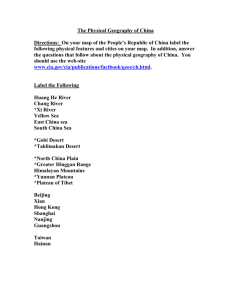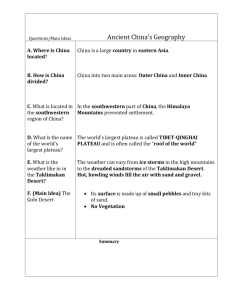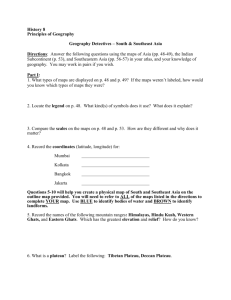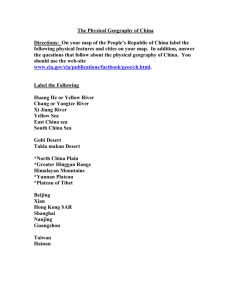World Geography - Waterford Public Schools
advertisement
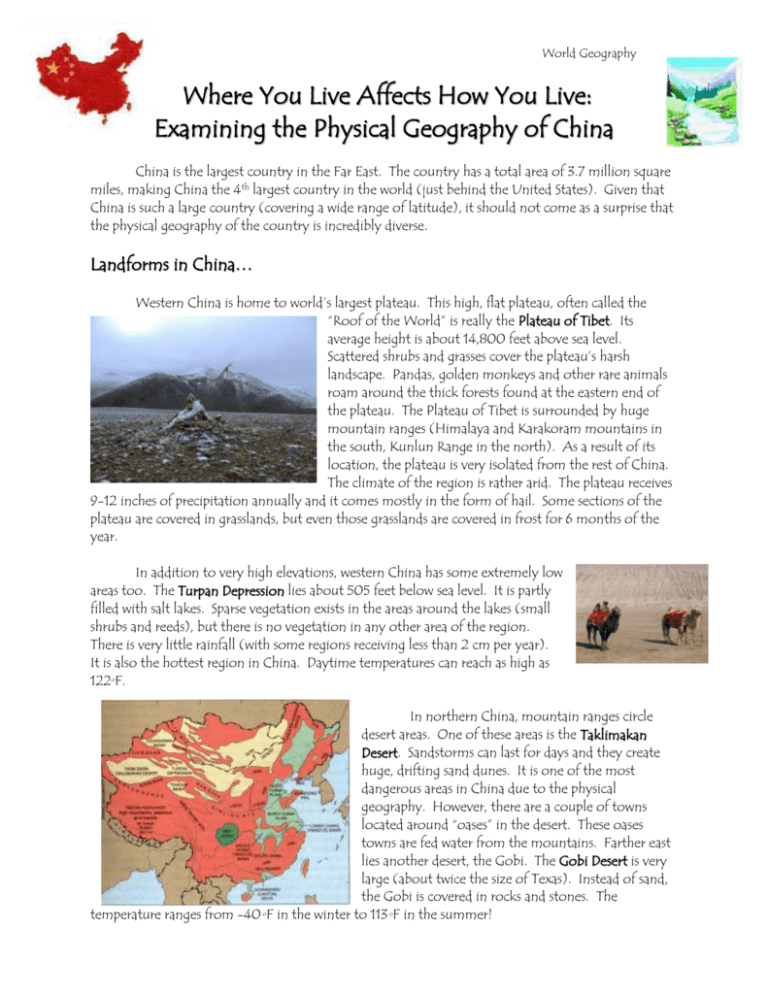
World Geography Where You Live Affects How You Live: Examining the Physical Geography of China China is the largest country in the Far East. The country has a total area of 3.7 million square miles, making China the 4th largest country in the world (just behind the United States). Given that China is such a large country (covering a wide range of latitude), it should not come as a surprise that the physical geography of the country is incredibly diverse. Landforms in China… Western China is home to world’s largest plateau. This high, flat plateau, often called the “Roof of the World” is really the Plateau of Tibet. Its average height is about 14,800 feet above sea level. Scattered shrubs and grasses cover the plateau’s harsh landscape. Pandas, golden monkeys and other rare animals roam around the thick forests found at the eastern end of the plateau. The Plateau of Tibet is surrounded by huge mountain ranges (Himalaya and Karakoram mountains in the south, Kunlun Range in the north). As a result of its location, the plateau is very isolated from the rest of China. The climate of the region is rather arid. The plateau receives 9-12 inches of precipitation annually and it comes mostly in the form of hail. Some sections of the plateau are covered in grasslands, but even those grasslands are covered in frost for 6 months of the year. In addition to very high elevations, western China has some extremely low areas too. The Turpan Depression lies about 505 feet below sea level. It is partly filled with salt lakes. Sparse vegetation exists in the areas around the lakes (small shrubs and reeds), but there is no vegetation in any other area of the region. There is very little rainfall (with some regions receiving less than 2 cm per year). It is also the hottest region in China. Daytime temperatures can reach as high as 122oF. In northern China, mountain ranges circle desert areas. One of these areas is the Taklimakan Desert. Sandstorms can last for days and they create huge, drifting sand dunes. It is one of the most dangerous areas in China due to the physical geography. However, there are a couple of towns located around “oases” in the desert. These oases towns are fed water from the mountains. Farther east lies another desert, the Gobi. The Gobi Desert is very large (about twice the size of Texas). Instead of sand, the Gobi is covered in rocks and stones. The o temperature ranges from -40 F in the winter to 113 oF in the summer! The eastern side of China is covered by plains that run along the Yellow Sea and the East China Sea. The Manchurian Plain is located in the northeastern part of China. The land is rich in fertile soil and the region has a continental climate with long, cold winters and hot, wet summers. The Manchurian Plain also contains natural resources such as iron ore, coal and oil. The North China Plain is located just south of the Manchurian Plain. The fertile soil located in the North China Plain is deposited by the Yellow and Yangtze Rivers. These rivers run throughout the plains. There are very few mountains or other natural barriers found in the North China Plain, making it one of the largest, uninterrupted plains in all of Asia. Natural Disasters… China is located along the Ring of Fire (a name given to the Pacific Coastal areas that have volcanoes and are prone to earthquakes). The eastern part of China has experienced many severe earthquakes in its long history. The last devastating earthquake in China was in 2008 which resulted in the deaths of over 68,000 people. Two of China’s rivers are also known for annual flooding. Each year, the Yellow and the Yangtze rivers flow over their banks and flood the surrounding landscape. While these floods have caused great damage to China (and resulted in people’s deaths), they also help China. The flooding replenishes the region with fertile soil from the overflowing river. Name: Date: Core: World Geography Physical Geography of China: Where You Live Affects How You Live Reflections… Directions: Use the Where You Live Affects How You Live: Examining the Physical Geography of China handout to answer the following question. 1. Explain how the physical geography of China might affect the way that the Chinese people live? Support your answer using two specific details from the reading (ATITIC). _________________________________________________________________________________ _________________________________________________________________________________ _________________________________________________________________________________ _________________________________________________________________________________ _________________________________________________________________________________ _________________________________________________________________________________ _________________________________________________________________________________ _________________________________________________________________________________ _________________________________________________________________________________ _________________________________________________________________________________ _________________________________________________________________________________ _________________________________________________________________________________ _________________________________________________________________________________ _________________________________________________________________________________ _________________________________________________________________________________ _________________________________________________________________________________ 4 Exemplary Insightful, well organized, and fluent Deep understanding of text is demonstrated Specific references to text are used to support ideas Text references are well interpreted and clearly connected to response 3 Proficient Thoughtful, organized, and fluent Clear understanding of the text is demonstrated Relevant references to text are used to support ideas Text references are explained and connected to response 2 Progressing Organized and somewhat fluent Basic understanding of text is displayed At least one relevant example from text is used to support ideas Text references are somewhat connected to response 1 Beginning Disorganized or confusing Limited or no understanding of text is displayed Limited or no examples from text are used to support ideas Text reference seems irrelevant to response Step 1. Analyze the Question. Read the “Reader Response” question and make sure you know what the question is asking. Highlight the 4 most important words in the question. Reader Response Question: Explain how the physical geography of China might affect the way that the Chinese people live? Support your answer using two specific details from the reading (ATITIC). What are some ways that physical geography of an area affects the people who live there? Examples of “Where You Live Affects How You Live” If a part of the country is very mountainous, people may not live there because it’s too difficult to farm and build houses. Step 2 Selecting Evidence (text/film support). Look at the reading. Identify two specific parts of China’s physical geography (landforms, water, climate, natural disasters). Write down two examples from your notes in the space provided. Evidence (text) Inference Step 3. Making an Inference. Write a sentence explaining how each of these physical features in China might affect the people who live there. Write each sentence in the “inference: column on the table above.
